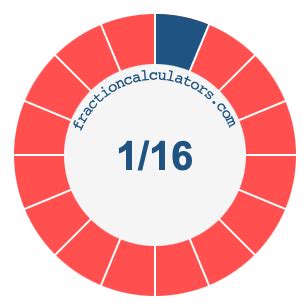What Is 1/16 As A Percentage
Kalali
Apr 06, 2025 · 5 min read

Table of Contents
What is 1/16 as a Percentage? A Comprehensive Guide
Converting fractions to percentages is a fundamental skill in mathematics with applications spanning various fields, from finance and statistics to everyday calculations. This comprehensive guide delves into the process of converting the fraction 1/16 into a percentage, providing a step-by-step explanation, practical examples, and exploring related concepts. We'll also discuss the importance of understanding this conversion in different contexts and offer tips for tackling similar problems.
Understanding Fractions and Percentages
Before we dive into the conversion of 1/16, let's quickly review the basic concepts of fractions and percentages.
Fractions: A fraction represents a part of a whole. It consists of two parts: a numerator (the top number) and a denominator (the bottom number). The numerator indicates how many parts we have, while the denominator indicates the total number of equal parts the whole is divided into. For example, in the fraction 1/16, 1 is the numerator and 16 is the denominator. This means we have 1 part out of a total of 16 equal parts.
Percentages: A percentage is a way of expressing a number as a fraction of 100. The symbol "%" represents "per cent," meaning "out of 100." For example, 50% means 50 out of 100, which is equivalent to the fraction 50/100 or 1/2.
Converting 1/16 to a Percentage: The Step-by-Step Method
Converting a fraction to a percentage involves two main steps:
Step 1: Convert the fraction to a decimal.
To convert a fraction to a decimal, we divide the numerator by the denominator. In the case of 1/16:
1 ÷ 16 = 0.0625
Step 2: Convert the decimal to a percentage.
To convert a decimal to a percentage, we multiply the decimal by 100 and add the "%" symbol.
0.0625 × 100 = 6.25%
Therefore, 1/16 as a percentage is 6.25%.
Alternative Method: Using Proportions
Another way to convert 1/16 to a percentage is by setting up a proportion:
1/16 = x/100
To solve for x (the percentage), we cross-multiply:
16x = 100 x = 100/16 x = 6.25
Therefore, x = 6.25%
Practical Applications of Converting 1/16 to a Percentage
The ability to convert fractions like 1/16 to percentages is crucial in various real-world scenarios:
-
Finance: Calculating interest rates, discounts, and profit margins often involves converting fractions to percentages. For example, if a bank offers a loan with an interest rate of 1/16, understanding this as 6.25% helps in comparing it with other loan offers.
-
Statistics: Presenting data in percentages makes it easier to understand and compare. If a survey shows that 1 out of 16 respondents prefer a particular product, representing this as 6.25% provides a clearer picture of the preference.
-
Measurement and Scaling: In fields like engineering and construction, accurate scaling and measurements are critical. Converting fractions to percentages ensures precision in calculations. Imagine working with blueprints where dimensions are expressed as fractions; understanding their percentage equivalents ensures accurate construction.
-
Everyday Calculations: From calculating tips in restaurants (e.g., 1/16 of the bill) to understanding sale discounts (e.g., a 1/16 reduction), converting fractions to percentages streamlines daily computations.
Understanding the Significance of Decimal Places
In the conversion of 1/16, we obtained 6.25%. The number of decimal places used depends on the level of precision required. While 6.25% is accurate, some applications may require more decimal places. For instance, if we were working with very large numbers, even small differences could have significant implications.
It's important to understand that rounding off can introduce minor errors, especially when dealing with multiple calculations based on the converted percentage. Maintaining precision throughout the process ensures accurate final results.
Related Fraction to Percentage Conversions
Understanding the conversion of 1/16 can help you grasp similar conversions more easily. For instance:
-
1/8: This is double 1/16. Therefore, 1/8 is 12.5% (6.25% x 2).
-
1/4: This is double 1/8. Therefore, 1/4 is 25% (12.5% x 2).
-
1/2: This is double 1/4. Therefore, 1/2 is 50% (25% x 2).
By recognizing these relationships, you can quickly estimate and verify other fraction to percentage conversions.
Tips for Mastering Fraction-to-Percentage Conversions
-
Practice: Regular practice is key to mastering this conversion. Start with simpler fractions and gradually increase the complexity.
-
Use a Calculator: While understanding the manual process is crucial, a calculator can help you perform the calculations quickly and efficiently.
-
Learn the Common Conversions: Memorizing common fraction-to-percentage conversions (like 1/4 = 25%, 1/2 = 50%, 3/4 = 75%) can speed up your calculations.
-
Check Your Work: Always double-check your calculations to ensure accuracy. Using a different method to verify your answer is always a good idea.
Conclusion
Converting 1/16 to a percentage is a straightforward process involving two main steps: converting the fraction to a decimal and then the decimal to a percentage. Understanding this process and its applications is essential in various contexts. By mastering this skill, you enhance your mathematical capabilities and improve your problem-solving skills across various disciplines. Remember to practice regularly, utilize available tools, and verify your results to become proficient in these types of conversions. The ability to easily convert fractions to percentages will empower you to tackle complex calculations and solve problems more effectively.
Latest Posts
Latest Posts
-
3 Out Of 40 As A Percentage
Apr 08, 2025
-
What Is 82 Degrees Celsius In Fahrenheit
Apr 08, 2025
-
What Percent Is 2 Of 7
Apr 08, 2025
-
Biochemical Reactions In The Body Must Occur In
Apr 08, 2025
-
18 Is What Percent Of 15
Apr 08, 2025
Related Post
Thank you for visiting our website which covers about What Is 1/16 As A Percentage . We hope the information provided has been useful to you. Feel free to contact us if you have any questions or need further assistance. See you next time and don't miss to bookmark.